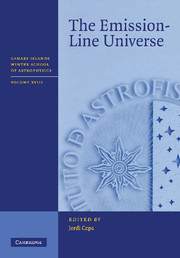Book contents
- Frontmatter
- Contents
- List of contributors
- List of participants
- Preface
- Acknowledgements
- 1 What can emission lines tell us?
- 2 The observer's perspective: Emission-line surveys
- 3 The astrophysics of early galaxy formation
- 4 Primeval galaxies
- 5 Active galactic nuclei
- 6 Chemical evolution
- 7 Galactic sources of emission lines
- 8 Narrow-band imaging
- 9 Long-slit spectroscopy
- 10 Basic principles of tunable filters
4 - Primeval galaxies
Published online by Cambridge University Press: 23 November 2009
- Frontmatter
- Contents
- List of contributors
- List of participants
- Preface
- Acknowledgements
- 1 What can emission lines tell us?
- 2 The observer's perspective: Emission-line surveys
- 3 The astrophysics of early galaxy formation
- 4 Primeval galaxies
- 5 Active galactic nuclei
- 6 Chemical evolution
- 7 Galactic sources of emission lines
- 8 Narrow-band imaging
- 9 Long-slit spectroscopy
- 10 Basic principles of tunable filters
Summary
What do we mean by primeval? According to the Webster dictionary “Primeval: adj. [primaevus, from: primus first + aevum age] of or relating to the earliest ages (as of the world or human history)”. We will follow this definition and mostly discuss topics related to galaxies in the “early” Universe, whose limit we somewhat arbitrarily define at redshifts z ≳ 6, corresponding approximately to the first billion years (Gyr) after the Big Bang. In contrast the frequently employed adjective “primordial”, defined as “Primordial: adj. [primordialis, from primordium origin, from primus first + ordiri to begin] a) first created or developed b) existing in or persisting from the beginning (as of a solar system or universe) c) earliest formed in the growth of an individual or organ”, should not be used synonymously, for obvious reasons. Luckily “primeval” encompasses more than “primordial”, otherwise there would not be much in the way of observational aspects to discuss (now in 2006–2007) in these lectures!
If we follow the history of discoveries of quasars and galaxies over the last few decades it is indeed impressive to see how progress has been made in detecting ever-more-distant objects, increasing samples at a given redshift and their analysis and interpretation. During the last decade, approximately since the pioneering observations of the Hubble Deep Field in 1996 (Williams et al. 1996) and the spectroscopic studies of a large sample of star-forming galaxies at redshift 3 by Steidel and collaborators (Steidel et al. 1996), the observational limits have continuously been pushed further, reaching now record redshifts of z ∼ 7 (secure) (Iye et al. 2006) but maybe up to ∼ 10 (Pelló et al. 2004; Richard et al.
- Type
- Chapter
- Information
- The Emission-Line Universe , pp. 106 - 137Publisher: Cambridge University PressPrint publication year: 2008



